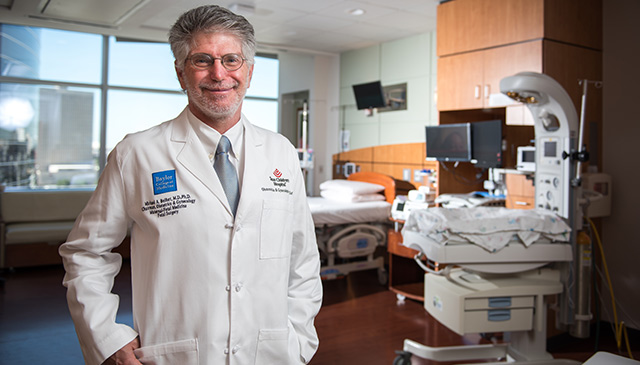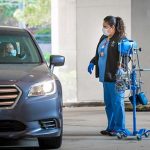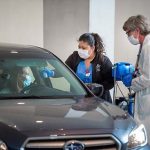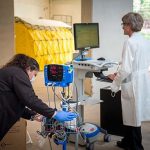The CDC has reported that a little over 30,000 pregnant women have received the COVID-19 vaccine. There have been no specific safety signals that have been observed in these pregnant women. Doctor Mark A. Turrentine explains further in this short video.

As Texas Children’s continues to vaccinate our team members and patients against COVID-19, we have also received many questions around women’s health, especially from those of you who are currently pregnant, nursing or planning to start a family.
Here are some of the most common questions you have asked. Additionally, our Texas Children’s and Baylor physicians recently made this video to discuss these concerns, which you are encouraged to watch and share.
I am currently pregnant. Should I receive the COVID-19 vaccine?
You should discuss the decision to receive the COVID-19 vaccine further with your provider – not only on the vaccines’ risks and benefits, but also your risk of moderate or severe disease if you were to remain unvaccinated and become infected with the virus.
The Society for Maternal Fetal Medicine (SMFM) and the American College of Obstetrician Gynecologists (ACOG) has issued guidance statements to aid patients in evaluating the benefits and potential risks. There are several facts that are worth knowing when making this decision:
- The risks of COVID-19 disease in pregnant women are greater than in non-pregnant women.
Specifically, pregnant women are up to five times more likely to be hospitalized, three to four times more likely to need to be cared for in an ICU, and two to three times more likely to require life-saving measures (like a breathing tube or life support). In addition, while the data is not yet complete, there is at least a small increased risk of maternal death, stillbirth, and preterm birth with COVID-19 disease during pregnancy. Black and Latino women have an especially increased risk of severe disease and death from COVID-19. - The COVID-19 vaccine has not yet been thoroughly tested in pregnant women.
Pregnant women were not allowed to take part in the clinical trials of the vaccine. However, a few people received the vaccine in the clinical trials and did become pregnant. Although these were small numbers, there were no reports of problems and monitoring continues. - The Pfizer and Moderna authorized vaccines are not a live vaccine, meaning that you cannot become infected with the virus when you receive the vaccine.
Although about 4 in 100 people had a fever with the first dose of the Pfizer vaccine in the trial, and 16 in 100 after the second dose in the trial, this does not mean they became infected. These are anticipated responses to the vaccine and clues that it is arming your immune system to fight the virus should you become infected. Pregnant and lactating women can take acetaminophen (Tylenol) to help with the fever and muscle aches that might come with receiving the vaccine, and it won’t cause harm or lessen the effectiveness of the vaccine.
What if I am nursing? Can the virus be transmitted to my infant or toddler through the vaccine?
Because the vaccine does not contain a live virus, there is no virus to transmit with nursing.
Is there an increased miscarriage rate and/or risk?
This is unknown at this time. However, as summarized above, it is felt that the benefits of the vaccine outweigh any possible small and still theoretical risks. In the Pfizer trial, the only women suffering miscarriage were in the placebo group. However, the data is simply not robust enough to make any conclusions.
Watch this video as Dr. Michael Belfort shares some of his team’s outstanding achievements over the last decade at Texas Children’s Pavilion for Women.

As Dr. Michael Belfort marks his 10-year milestone at Texas Children’s, he reflects on some of his team’s notable accomplishments over the last decade and shares his vision for the future. Read more

Tara Paulose’s pregnancy with twins was not easy and the pandemic made it even harder with safety precautions preventing her husband from attending her many visits to the Pavilion for Women to see her doctor and get updates on her babies’ progress.
At one point, Paulose said she was put on bedrest except for trips to the hospital and even then she was told to limit the time she spent on her feet. On those trips, her husband would drive her to her appointment, help her out of the car and into a wheelchair, wheel her through the screening process and then, per hospital safety protocols, send her on her way.
Paulose then would wheel herself to the patient screening table where she would not only be checked for COVID-19 symptoms but befriend Sharla Weindorff, a 22-year Texas Children’s employee charged with leading a small, tight-knit team of people responsible for screening and helping patients coming to the Pavilion for Women.
“Sharla graciously wheeled me to many of my appointments and she did so with kindness and a smile,” Paulose said. “That might seem like a small thing but it’s not. It gave me a lot of comfort during a very trying time.”
After Paulose gave birth to her two healthy babies and returned home from a brief stay in the Neonatal Intensive Care Unit, she reached out via email to Weindorff to thank her and send her a picture of her new bundles of joy. The email and picture meant the world to Weindorff, who said she teared up and got goosebumps while reading Paulose’s message.
“It reminded me why I’m here right now,” Weindorff said. “I’m extremely grateful to have an opportunity to be here at the hospital helping whenever, wherever and however I can.”
Other members of the screening team have had similar experiences with patients and many have said that working together to keep people safe has offered them a chance to meet new people, create new friendships, and be useful in uncertain times.
“It makes me feel so good that I can help somebody,” said Mel Cardenas, a member of the screening team. “I believe this is an experience I won’t forget.”
Cardenas, Weindorff and the team of three other screeners and one elevator operator was formed in June when Pavilion leadership decided they wanted the people screening their patients to be Pavilion employees who knew the building well and could easily answer patient’s questions.
Four members of the team – Cardenas, Patti Lambert, Andrea Savannah and Weindorff – all are administrative assistants in the Pavilion. Yajaira Mancia from International Services joined the team via Labor Pool and liked it so much she requested a regular shift with the team, and Samuel Gil is the team’s elevator operator keeping everyone safe by helping to enforce the hospital’s social distancing rules. Since they started working together, the team has screened more than 30,000 patients.
“I am so impressed with this team and what they’ve been able to accomplish together for the good of our patients, families and each other,” said Michele Birsinger, assistant vice president for Women’s Services. “They are doing an incredibly important job with remarkably positive attitudes.”
Lambert said the experience has been eye-opening because it has exposed her to more patients and the issues they are dealing with when they come to the hospital seeking care. She said many of the women she’s encountered are experiencing high risk pregnancies and that telling them their loves ones can’t accompany them to their appointment is hard but the right thing to do under the circumstances.
“Most of them are very kind and understanding,” Lambert said. “But, we understand it’s disappointing and difficult, and try to help make their experience as comforting as possible.”
Savannah said she’s learned a lot about Texas Children’s safety protocols by working with the screening team and that the knowledge she’s gained makes her feel proud of the organization’s efforts to keep everyone healthy and safe.
“I am very happy that we have been given the opportunity to be the gatekeepers that protect the hospital,” she said. “We work really well together.”
Mancia agreed and said the past few months have been some of her best at Texas Children’s.
“I’ve never felt so comfortable at my job,” she said. “I will never forget being part of something so great during such a hard time.”
2020 has been an unprecedented year filled with many challenges. We’ve engaged in social distancing practices like we have never done before. We are wearing protective face masks, both at work and in public, in an effort to protect ourselves, each other, and prevent the further spread of the coronavirus.
But despite the uncertainty and daily disruptions caused by the COVID-19 pandemic, this health crisis has prompted our physicians, nurses and other patient care staff to explore innovative, non-traditional approaches to patient care processes – like e-rounding – to enhance the provider/patient experience.
Daily patient rounding has been around for centuries, and is an important part of the patient care process. Before COVID-19, a group of multidisciplinary staff would gather in or outside a patient room to discuss the patient’s condition and plan of care with the patient’s family, taking into account the experience, concerns, questions and needs of the patient. Through this multidisciplinary, family-centered approach, each team member would then contribute their expertise to support the best possible care/outcomes for the patient.
To adapt to COVID-19 and to ensure social distancing practices are followed, our critical care teams began conducting patient e-rounding in April, which has been a beneficial change from the norm.
“E-rounding has been a big change for us,” said Dr. Jordana Goldman, attending physician in Critical Care. “Rounds are as old as time in medicine and so it takes a little bit of practice to get use to it. But once you get the flow of it, it really works well. Our physician and nursing leaders, and the e-Health and IS teams have been very supportive in helping us leverage new technology to make e-rounding possible.”
Through the VidyoConnect platform, virtual “rooms” are created that are then available for all rounding team members to join. During e-rounding, an attending physician, bedside nurse and family member, can be outside the patient’s room in front of a computer screen while maintaining social distancing, and can communicate virtually with remote team members including our consultants, the provider team (consisting of APPs, fellows and residents) dietitian, pharmacy, Respiratory Therapy support and other members.
“We facilitated the implementation of e-rounding by working with Dr. Goldman and Dr. Aarti Bavare to integrate their ideal workflow using the software and hardware that we already had available,” said Dr. Robert Ball, medical director of e-Health. “It was the team work of Information Services, e-Health and the physician champions that made it a reality. When you have amazing innovators in every corner of our organization working together to enhance this process, there are no obstacles that cannot be overcome.”
Since e-rounding was first introduced in the PICU and CICU in April, e-rounding has expanded to other parts of the hospital including the acute care cardiology floor. PHM has been working on the acute care side on a version of e-rounds to help with the education of the residents and medical students. Plans are underway to expand e-rounding capabilities to the Pavilion for Women and NICUs with the option of e-rounding being made available to all inpatient areas at our three hospital campuses in the coming weeks.
Our e-Health teams are also working on the ability to leverage VidyoConnect to communicate with families in a HIPAA compliant way so they can join rounds when they are not able to be at the bedside.
“The disruption of COVID-19 has allowed us to take a closer look at our rounding practices and see how we can improve them for our patients, team, learners and consultants,” Goldman said. “This is a very new process for us, but our team’s willingness to engage in this novel approach has been pretty phenomenal.”
When Kirsti Clifford found out she was pregnant with her second child, she was excited beyond belief. She was grateful to be giving her daughter a sibling and she was looking forward to pregnancy and delivery more so than with her first child because she knew what to expect. Then the pandemic happened and Clifford’s anxiety rose right along with it.
“There is so much unknown.” Clifford said. “I have felt much more uneasy this time and am trying to be really careful. I am limiting my exposure, social distancing and not going out unless I have to.”
To reduce the anxiety of expectant moms like Clifford, and to lower their risk of COVID-19 exposure and infection, Texas Children’s Pavilion for Women has opened a drive-through prenatal clinic at our Medical Center Campus.
A group of Texas Children’s obstetrics and gynecology physicians in consultation with the American College of Obstetrician Gynecologists (ACOG) came up with the idea while discussing how to adequately care for pregnant mothers while reducing their risk of contracting COVID-19 while traveling to hospitals or clinics for a prenatal exam.
“Providing access to prenatal health care while limiting exposure of both obstetric health care professionals and patients to COVID-19 is challenging,” said Dr. Mark Turrentine, a Texas Children’s obstetrician and gynecologist. “Although reductions in the frequency of prenatal visits and implementation of telehealth interventions provide some options, there still remains a need for patient–health care professional visits.”
The drive-through prenatal care clinic at Texas Children’s allows pregnant women who do not need to be seen in the clinic to remain in their vehicles while being assessed by a health care professional, thus reducing potential patient, health care professional, and staff exposure to COVID-19.
View photos of the drive-through clinic below.
The drive-through visits include key elements of a prenatal exam such as blood pressure measurements for evaluation for hypertensive disorders of pregnancy, fetal heart rate assessment, and selected ultrasound-based measurements or observations, as well as face-to-face patient–health care professional interaction.
“Patients using the drive-through clinic feel reassured that they can actually see a health care provider and hear their baby’s heartbeat without having to come into our facility and risk being exposed to the virus,” Turrentine said. “Our providers like it as well. They enjoy being able to provide patients with an option that might better suit their needs during these unprecedented times.”
Clifford said she used the drive-through clinic at the Medical Center Campus for her 30-week appointment because she didn’t want to take any unnecessary risks, and that it turned out to be a great decision. She said she got her blood pressure taken and that, more importantly, she got to hear her baby’s heartbeat.
“I appreciated the setup because we can still get some of the important monitoring that we need to feel reassured,” Clifford said. “It’s a creative solution that I would opt to use again.”
In conjunction with Turrentine and other Texas Children’s obstetrics and gynecology physician, Obstetrician and Gynecologist-in-Chief Dr. Michael A. Belfort recently published a paper about the drive-through prenatal clinic in Obstetrics & Gynecology, the official publication of ACOG. In that paper, Belfort said the drive-through model is projected to reduce the number of in-person clinic visits by 33 percent per patient compared with the traditional prenatal care paradigm, using equipment and supplies that most obstetric clinics in the United States can access.
“What we have seen so far at Texas Children’s is that the concept of a drive-through prenatal clinic works,” Belfort said. “They are reducing patient anxiety without compromising quality of care. It’s a win-win for everyone involved.”
Texas Children’s is also using drive-through capabilities for a variety of services including per-operative COVID-19 testing at all three of our hospital campuses and will expand these options as we continue to refine how we care for our patients.





